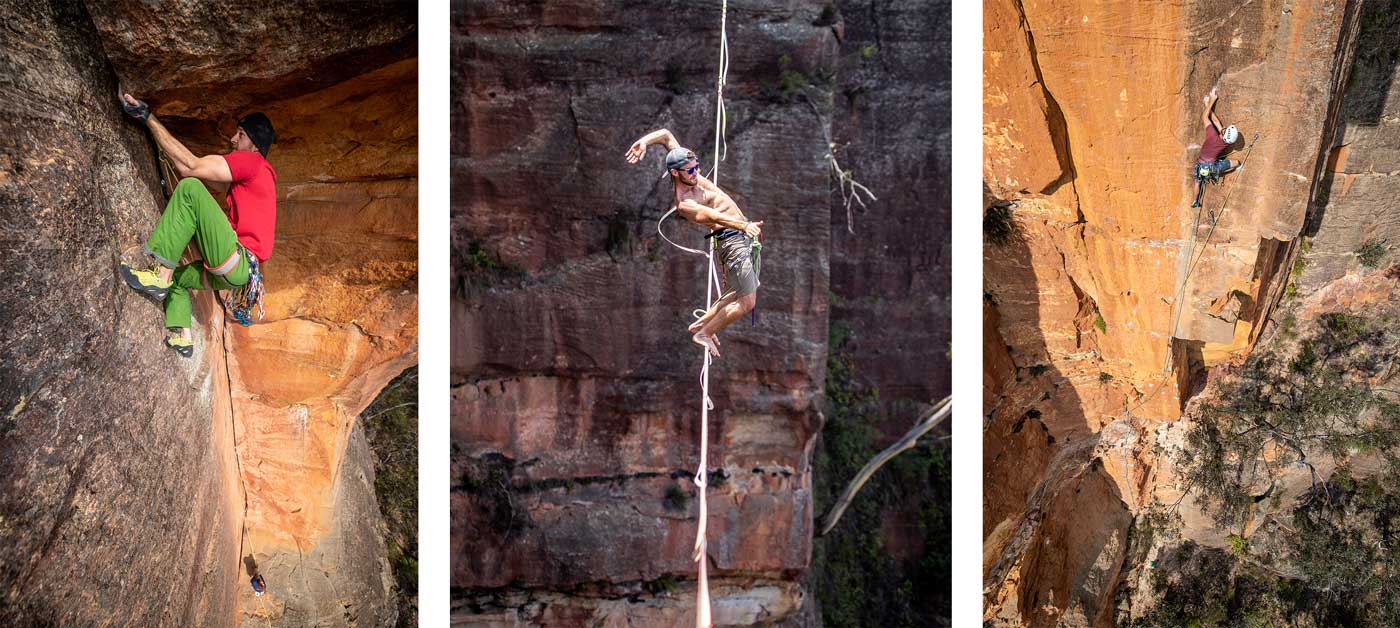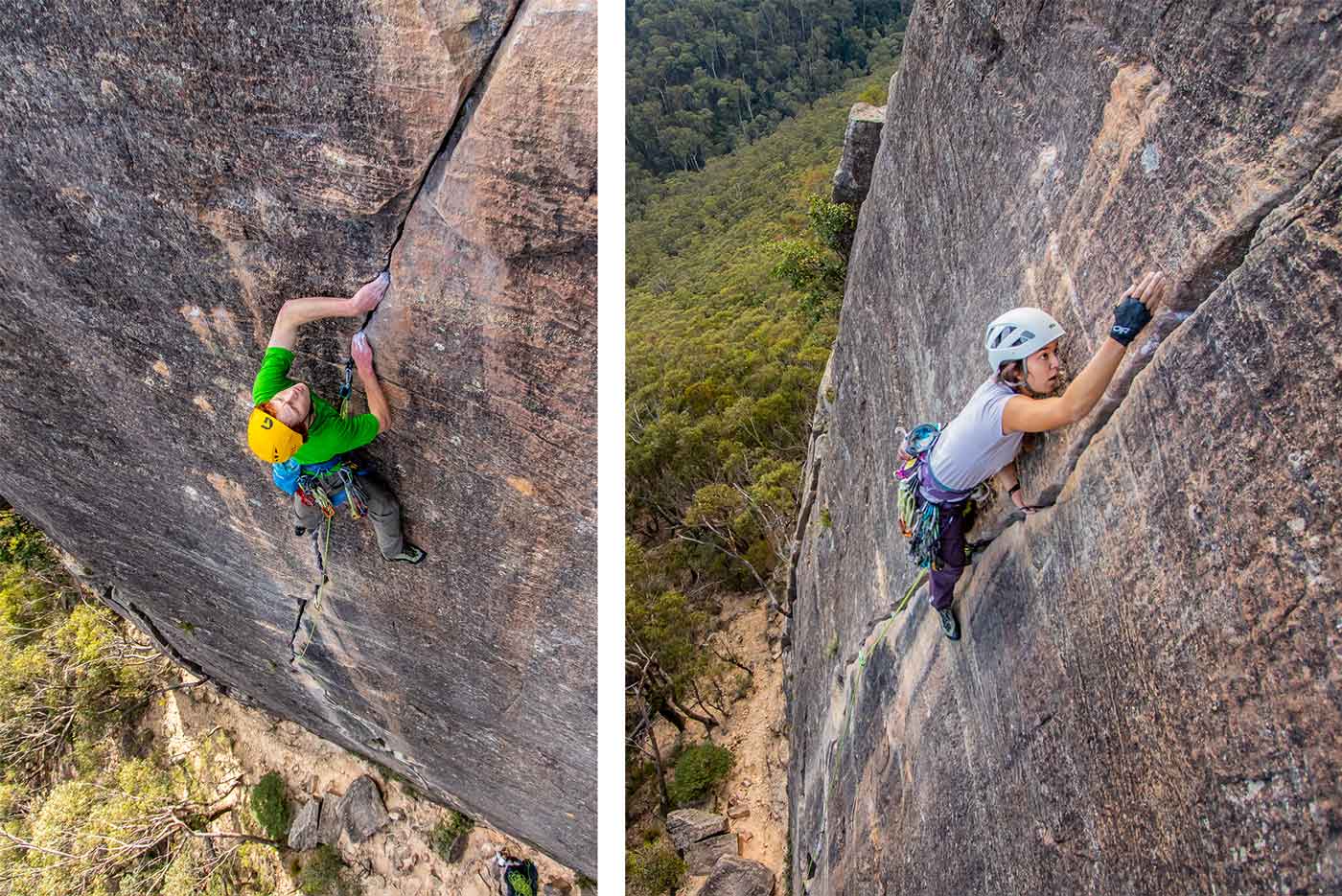You Want To Get Into Climbing Photography? With Jared Anderson

Many climbers are looking to combine their love of photography with their passion for the vertical world but it is often hard to know where to start and how to go about taking photos in a complex environment. We spoke to climbing photographer Jared Anderson about his journey into the world of climbing photography and his philosophy on capturing these scenes. Many Sydney and Blue Mountain’s climbers will be very familiar with Jared’s work. He’s almost become a bit of a photojournalist for the Blue Mountains and is constantly giving updates and sharing photographs of climbers he’s captured with the local climbing community. Jared has been climbing on and off for 10 years and interested in photography for just as long, but only recently has he combined the disciplines. This guides how he approaches his shoots.
Why are you doing it?
Jared’s Story
For Jared, climbing photography is equally about having an adventure in itself as well as capturing one. Inspiring the local climbing community is also a significant factor. Whilst many professional photographers take spectacular photos of jaw-dropping grade 35 sport routes and muscly boulderers sending impossible V14s, for most mere mortals these photos are amazing to look at but are not that attainable. He believes shooting moderately graded climbs not only allows you to take photos of more people, but it also means that you are taking photos of climbs that people can be inspired by and genuinely aspire to. Jared says that it’s quite rewarding to see people tagging their climbing partners in his photos of climbs. From his own perspective, the photos are simply “memories of the shared adventure”. This affects how he prepares for photography days and what he does in the moment. For example, whilst many professional photographers ask their subjects to repeat moves and sequences, Jared prefers to take photos on the fly, despite knowing that he runs the risk of missing the key moment.
Takeaways
There are a number of reasons why you might be getting into the photography aspect of climbing; maybe it’s to combine two passions, maybe it’s because you are injured or maybe it’s simply to document the adventures you are going on. Regardless it is important as a new climbing photographer to determine why you are entering this aspect of the sport, as this will guide how you run your shoots. For Jared, he says it is about capturing memories of the experience. Hence, he “shoots the climb” rather than asking climbers to specifically climb for the shoot. This mind set could be less efficient if you are shooting for a job.
One thing that good climbing photographers have in common is enjoying their art. According to Jared: “Having fun is the important part; climbing photography involves lots of preparation, lots of effort, heavy packs, there is a small audience and there is no money in it for most people. If it’s not fun, it’s silly.”

How do you get started?
Jared’s Story
Jared began on the climbing photography scene when his Mount Cook trip in New Zealand was cancelled due to rock fall and avalanche in the area. With a free week and not much to do, he took to climbing photography as a time filler. He was inspired by a guide who he had climbed the Matterhorn and the Eiger with, who was quite skilled behind the lens. After a quick dabble in taking photos, Jared quickly realised that he much preferred the technical aspects of rigging a safe shoot to the insecurity of climbing. In his own words; “I’m a bit of a gear lover. If I was to become a serious climber, I feel like I would become an aid climber”. On top of “lots of YouTube videos”, Jared also did a five day rope access course that helped him to develop a good understanding of the rope systems involved in positioning the shot.
Takeaways
The process of setting up for and taking photos in the vertical world requires a solid understanding of rigging and rope management skills. Newer photographers should be competent in descending and jumaring a rope, redirecting their belays and hiding the rope from the camera prior to setting out on a shoot. A mentor or ropes course can help to provide time-proven methods and tricks to achieve these goals and is a great way to enter the field of climbing photography.

Tips and Tricks for Starting Out
Prioritise Safety
Being very conscious of safety is Jared’s number one tip for new photographers. This means looking after both your own safety and the safety of the climbers. One of the things that Jared is constantly thinking about is “ropes have a high tensile strength, but cut really easily on sharp rocks”. This makes hanging and swinging around on a rope significantly more hazardous in terms of rope failure than climbing on one. Rope protectors and edge selection are important. It is also crucial that you don’t drop gear or knock rocks onto your climbers. A carabiner dropped from twenty meters up can do a lot of damage let alone a rock or a lens. Being aware of this is even more important when you are abseiling to the side of the climbing line, where the rock is less likely to have been cleaned and could have loose sections. Being safe is important both for the longevity of your photography career and for the confidence it inspires in your climbing party.
Start Small
Starting on an easily accessed single pitch route that you can safely walk to the top of, in a common area where your rope touches the ground is another tip Jared has when taking your first photos. Not only does this mean that you can abseil to safety in the case of an unforeseen issue but also that there is likely a bunch of people around to help you if you get stuck. Everyone has moments when things could have gone a little better, and times like these are best had when there are others around to help out.
Come Prepared
Nobody wants to be waiting five hours for the photographer to locate a suitable anchor tree. Studying the existing photos and literature and even doing a recce on the selected route allows you to turn up ready to go. Things to look for are anchors, places to redirect your abseil, how much rope you will need and where you want to shoot the photo from. The second component to this is explaining the plan to your climbing party. It is imperative that they know what is going on. Another simple way of improving your photos is asking the climbers to come in bright clothing to help them stand out from the rock. According to Jared “the planning for Wafer Thin Fin project was lots of effort, it was obsessive, almost silly”. Planning can be hard work, but the three days of site visits, rigging and shooting Jared took on Wafer Thin Fin project provided him with his favourite photo to date. A smooth shoot starts at home.
Be Ready to Adapt
While it is important to plan, Jared says that research and preparation can only get you about 50% of the way. Good shoots usually require adaptation. Topos are often inaccurate, anchors are in different spots and photos may be deceptive. While this is less of an issue for climbers, positioning on a shoot can be a very precise element. You have to be able to change your plans to deal with the situation in front of you.
Do Something New
There are a lot of photos out there so it is important to be a little bit creative when selecting and setting up a shot. For Jared this means travelling a bit off the beaten path and focussing on more adventurous climbs. He also suggests taking a new perspective on routes, your research will bring up previous photos of the route you are looking at and it is worth trying to capture new angles or different features of the climb.
Climb Yourself
Being a climber yourself, even a bad one, has large benefits for your photography. In Jared’s words; “you’ve got to have that passion and understanding for the mechanics of climbing”. Whilst not a deal breaker, understanding what is going through the climber’s mind and how it feels to take the sharp end can be very helpful. Consider it part of the preparation phase!
Be A Tough Self-Critic
Someone will always have something negative to say about every photo and the trick is working out whether this negativity will overrule the photo. Sometimes, some photos are just best kept off social media! This is one of the biggest lessons Jared has had to learn. Some of Jared’s reasons for not sharing photos include large trad runouts, poorly tied knots and unsafe practices. Despite this, it is important to remember that you are taking the photos firstly for yourself and secondly for others. The way you personally remember an event can have a major effect on how the photo looks to you.
To Visit Jared Anderson's Instagram Page Click HERE
Written by: Dan Butler - Mountain Equipment Trad Lad
Acknowledgment
Mountain Equipment would like to thank Jared Anderson for taking the time out to chat to us and share his thoughts and expertise. On top of this we just want to thank him for his contribution to the Blue Mountains climbing community! It's always awesome to log onto the Blue Mountains Facebook group and see consistent quality posts from him of climbers at all levels. Some of our staff have featured in a few and it definitely ignites the stoke in the shop when we scroll through them.

